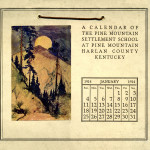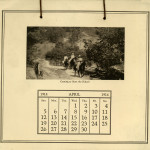Pine Mountain Settlement School
Series 17: PUBLICATIONS PMSS
CALENDARS
1914

1914 Calendar Image – January. [cale_1914_013.jpg]
TAGS: Pine Mountain Settlement School calendars, 1914 calendar, John Spelman III, Arthur Dodd, Mary Rogers, fund-raising, painting, printmaking, photography, print shop
PUBLICATIONS PMSS Calendars 1914
The first calendar published by the Settlement School, the 1914 calendar, served as both a fundraising appeal instrument as well as a gift and first-year update of the School’s progress. Co-director Ethel de Long wrote the following in a letter to Board members, dated October 31, 1913:
We expect that the school calendars will be ready for sale about the middle of November. The first page has a 3-color print made after a poster that Mr. Jonas Lie of New York got up for my summer speech, making a very charming thing. The other pages have excellent prints and some descriptive matter. The University Press, which is doing the work for us, considers that the results will be very handsome. We shall sell them for 40 or 50 cents.
The calendar is important for its very early photographs of the School. It also is important in establishing an annual tradition of the School tied to development and for building an annual outreach with supporters of Pine Mountain Settlement School and its programs.

1914 Calendar. January [cale_1914_001_mod.jpg]
TRANSCRIPTION: PUBLICATIONS PMSS Calendars 1914
1914 PMSS Calendar
FEBRUARY
The Ground for the first building of the Pine Mountain Settlement School was broken May 15, 1913, but its real beginning dates back thirty years, when Mr. William Creech first conceived the idea that there ought to be some day a school at the headwaters of Greasy Creek. Ten years before, he had come across the Mountain from the headwaters of the Cumberland River to build him a home in the wilderness. Working at his farm by day, and his blacksmith’s forge by night, alone he developed a great idea of education. He believed that farming should be taught, and the hand industries kept alive, that teachers should know more than book-learning. Year by year as he saw more and more young men turn to such “public works” as logging and mining, he felt a great weakness in the new order of civilization and wanted a school that should arouse interest in the arts of farm and home. Because of his character and force, and his generous gift of land, this locality at the foot of Pine Mountain was chosen for the new rural school, whose ideals Mr. Creech had worked out long ago, with singularly prophetic vision.
MARCH
Few schools could start with a richer natural endowment. The two hundred and thirty acres are heavily timbered; there is an abundance of first-rate building stone; the coal veins on the land will supply the school for many years; and a splendid limestone branch, coming down from the heart of Pine Mountain, will furnish water for a large reservoir. The neighborhood knows nothing of the timber famine: this spring a man burned 75,000 feet of magnificent lynn and poplar timber in clearing some new land for corn.
But the richest asset of the community is the children! Within a radius of seven miles are eight hundred children who have never known the influence of a good school. People sometimes think the mountains are already over-supplied with schools. They do not realize that the 13,000 square miles of mountain land in Kentucky would more than cover the whole of Massachusetts and Connecticut — and that to object to a school at Pine Mountain because there is already and excellent one at Hindman is like denying a school to Philadelphia because there are educational opportunities in New York. Shut off behind Pine Mountain these children have no chance unless a school comes to their midst.
Its papers of incorporation give the school entire freedom in this large field of rural service. The Board of Trustees, an independent organization, is composed of men and women from different parts of the country who are deeply interested in working out such problems. They believe that the laws of health and sanitation, economic and intelligent ways of farming, a wise use of timber resources, practical cooking, sewing, home nursing, weaving, and woodwork, should be taught. They wish the school to cooperate in every way with the community ; to help solve the problem of recreation, by clubs, outdoor games, and wholesome social diversions; to share in the religious life by Sunday School work, and non-sectarian Christian association.
The plan is to build up a school where boys and girls can work in their way in the kitchen, the laundry, the workshop, and on the farm, learning how to do in the best possible manner the things they will have to do all their lives.
MAY
The cordial cooperation of the neighbors is shown in many generous, helpful ways. One man has loaned the school his cottage and store house for as long as they are needed, though he could have rented the building three times over. The Masons give the use of their hall. The timber for the first house was given and cut by the men of the community, — the first tree being felled by a seven-year-old, who had to work from sunup to sunset to get it chopped. Other needed timber has been bought at about half the market price, because of the owner’s interest in the school. Nearly every man for several miles around has offered to give one day a month for work on the forest, the clearing, or the farm. “If we haven’t money,” said one man who was voicing the opinion of many, “we have strength — and we can work for the School.”
AUGUST
Transportation facilities to the railroad are the poorest; There is nothing but a rough horseback trail across Pine Mountain, for eight miles. Not only is it enormously expensive to haul cement, nails, flour, supplies to say nothing of a sawmill, from the railroad, ten long, rough miles away, but no one here can market the surplus products of his farm. Men on this side the ridge have carried cook-stoves and cane-mills across the mountain on their backs! The School is making a great effort to get the County to build a good road across Pine Mountain; and the matter is being urged with so much enthusiasm by people all over Harlan County that it seems only a question of time before we shall have a highroad.
SEPTEMBER
The old arts of hackling, carding, spinning, dyeing, and weaving are half forgotten here, and unless the school can create a fireside industries department, all the wise lore of the older women, “whose hands have held the distaff” will be lost with the passing of their generation. The plan is to revive these hand-crafts, find a market for the home-spun and baskets that can be made hereabouts, and raise the standard to of work as rapidly as possible.
The School raised its own flax crop last year, and shortly will set up a loom in its living-room, where the younger women may learn “to look well to the ways of their household.”
*Not all months have text. See below.
GALLERY I: PUBLICATIONS PMSS Calendars 1914
1914 PMSS Calendar
[cale_1914_001_mod.jpg] through [cale_1914_012_mod.jpg]
- [Cover] 1914 Calendar. January
- “Mr. William Creech, Founder” of the School. 1914 Calendar. February
- 1914 Calendar. March
- “Coming to Start the School.” 1914 Calendar. April
- May 1914 Calendar. “The five-roomed Cottage, the Three Tents, Store House and Masonic Lodge where the School is temporarily established till its own buildings are ready.” [cale_1914_005_mod.jpg]
- “The Laundry.” 1914 Calendar. June
- “The First Day of School.” 1914 Calendar. July
- “Bringing in the School Sawmill from the Railroad.” 1914 Calendar. August
- “The First Flax Harvest.” 1914 Calendar. September
- “A Bit of the School Playground.” 1914 Calendar. October
- The PMSS Coal Bank just opened on the School Land.” 1914 Calendar. November
- “Some of Our Neighbors, all eligible for Membership in the D.A.R.” 1914 Calendar. December
GALLERY II: 1914 PMSS CALENDAR – Individual Photographs
[cale_1914_01_img.jpg] through [cale_1914_012_img.jpg]
[Note: March has no image.]
- 1914 Calendar. Image – January
- 1914 Calendar. Image – February
- 1914 Calendar. Image – April
- 1914 Calendar. Image – May
- 1914 Calendar. Image – June
- 1914 Calendar. Image – July
- 1914 Calendar. Image – August
- 1914 Calendar. Image – September
- 1914 Calendar. Image – October
- 1914 Calendar. Image – November
- 1914 Calendar. Image – December
See Also:
ETHEL DE LONG ZANDE 1913 BOT Report October 6, page 2.
ADMIN GENERAL 1913 Ethel de Long Report October 31
Return To:
PUBLICATIONS PMSS Calendars Guide
























